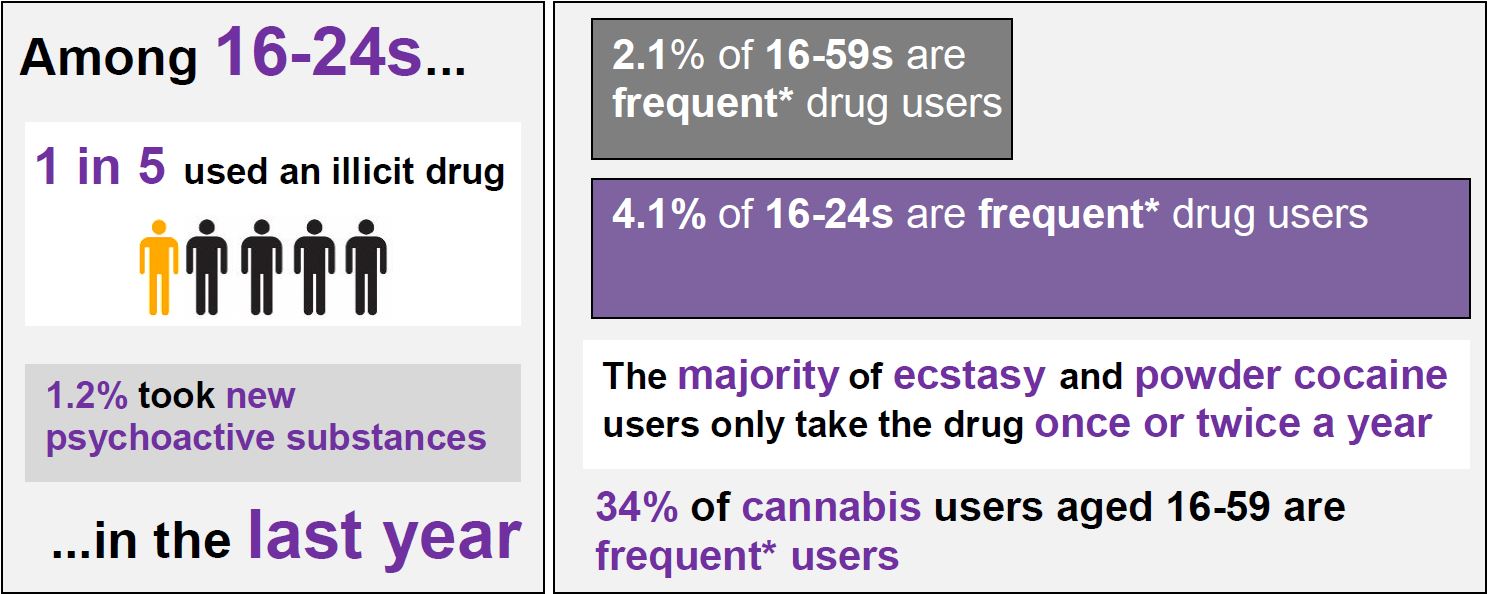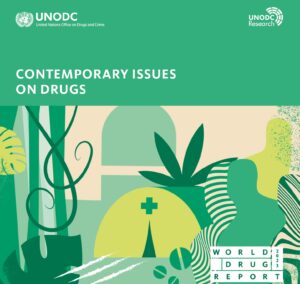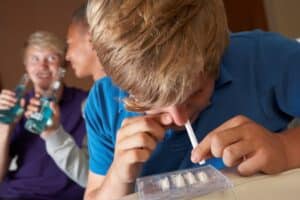Young people using (slightly) more cocaine & Ecstasy
The latest National Statistics on illicit drug use in England and Wales were released last Thursday (26 July 2018) by the Home Office and Office for National Statistics, based on self reported responses from the 2017/18 Crime Survey for England and Wales (CSEW).
Before turning to the figures, it’s good to remember that the CSEW figures are recognised as a reliable measure of mainstream recreational drug use, rather than problematic use. This is because CSEW is a household survey and doesn’t include people who are homeless, in temporary accommodation or in prison. The CSEW drug module has been runnign since 1996 so provides an excellent comparison of drug user over time.
CSEW reports separately on the drug use of 16-24 year olds from 25-59 year olds (indeed 60-74 year olds were involved in this year’s survey but the results are not yet pubilshed).
Main findings
- Around 1 in 11 (9.0%) adults aged 16 to 59 had taken a drug in the last year. This equated to around 3.0 million people, and was similar to 2016/17 (8.5%). The trend in last year drug use among 16 to 59 year olds has been relatively flat since the 2009/10 survey and the latest estimate was similar to the 2007/08 survey (9.4%). However, the 2017/18 prevalence estimate is lower than in 1996 (11.1%), when the time series began.
- Around 1 in 5 (19.8%) adults aged 16 to 24 had taken a drug in the last year. This proportion was more than double that of the wider age group, and equates to around 1.2 million people. This was similar to the 2016/17 survey (19.2%), but there was a decrease from 1996 (29.7%). There was no significant change compared with a decade ago (21.4% in 2007/08 CSEW).
- Around 1 in 23 (4.3%) adults aged 16 to 59 had taken a drug in the last month, while around 1 in 11 (9.5%) young adults aged 16 to 24 had done so. There was no significant change compared with the 2016/17 survey. However, both have decreased compared with a decade ago, where 5.4 per cent of 16 to 59 year olds reported taking a drug in the last month and 12.5 per cent of 16 to 24 year olds had done so.
- Around one-third (34.6%) of adults aged 16 to 59 had taken drugs at some point during their lifetime. There has been a decrease in levels of lifetime use estimated by the 2017/18 survey compared with a decade ago (36.0% in the 2007/08 CSEW), but this remains higher than the 1996 survey (30.4%).
- Around 1 in 29 (3.5%) of adults aged 16 to 59 had taken a Class A drug in the last year, equivalent to around 1.1 million people. This has increased compared with the previous year and a decade ago (2007/08; both 3.0%). Among young adults aged 16 to 24, 8.4 per cent had taken a Class A drug in the last year. This has increased compared with the 2007/08 CSEW (6.8%), but there was no significant change compared with the 2016/17 survey (7.0%).
- Class A drug use among 16 to 24 year olds has been increasing since 2011/12: While not statistically significant from year to year, there is an upward trend apparent in the use of Class A drugs, particularly among 16 to 24 year olds. Although there was no significant change from the 2016/17 estimate among this age group, there was an increase from the 2011/12 estimate (6.2% to 8.4%). This is mainly driven by an increase in powder cocaine and ecstasy use.
These findings are summarised in the infographic below:
Less common drugs
There were also changes between the 2016/17 and 2017/18 survey years for a number of less frequently used drugs, as outlined below. However, due to the very small numbers of people using these drugs, even small changes in prevalence can appear to be statistically significant. Changes from one year to the next should be interpreted with caution.
- LSD use increased among adults aged 16 to 59. Use increased from 0.3 to 0.4 per cent, equating to around 47,000 more people using the drug than in the previous year.
- Use of magic mushrooms increased among adults aged 16 to 59. Use increased from 0.3 to 0.4 per cent, equating to around 57,000 more people using the drug in the last year.
- Ketamine use increased among adults aged 16 to 59. Ketamine use doubled from 0.4 per cent to 0.8 per cent, equating to 141,000 more people using the drug than in the previous year. This was driven by an increase in ketamine use among 16 to 24 year olds from 1.2 per cent to 3.1 per cent. This is the highest estimate of ketamine use since measurement of this drug began in the 2006/07 survey.
- Use of tranquillisers (not prescribed by a doctor or other healthcare professional) increased among adults aged 16 to 59. Tranquilliser use among this age group increased from 0.4 per cent to 0.6 per cent, equating to around 63,000 more people using the drug in 2017/18 than in the previous year.
New psychoactive substances
The use of New Psychoactive Substances (NPS) has fallen since they were made illegal in May 2016.
Key findings are:
- Use of NPS has not changed in the last year. Approximately 0.4 per cent of adults aged 16 to 59 had used NPS in the last year (equivalent to around 121,000 adults). While this was the same level as in the 2016/17 CSEW, it was lower than the 0.7 per cent found in the 2015/16 survey.
- As in previous years, around half of all NPS users were aged 16 to 24. In the last year 1.2 per cent of adults aged 16 to 24 used NPS (equivalent to around 70,000 young adults).
- People who had visited a pub or nightclub, consumed alcohol, or used another drug, were more likely to have used NPS in the last year than those who had not. This was true for young adults aged 16 to 24 as well as the wider 16 to 59 age group.
- Herbal smoking mixtures were still the most commonly used NPS in the last year, although there was an increase in the use of liquids. A third (33%) of last year users aged 16 to 59 had smoked a herbal mixture on the last occasion that they used NPS. One in four (25%) ingested a liquid, which was twice as high as the previous year (12%).
- NPS were still more likely than other illicit drugs to be obtained from shops and the internet. Around 30 per cent of last year NPS users aged 16 to 59 had obtained the last NPS they used from either a shop (15%) or the internet (15%), compared with 5 per cent for other illicit drugs (4% from a shop, 1% from the internet).









4 Responses
Where can I find more information in relation to alcohol please?
Latest alcohol trends: https://www.russellwebster.com/alcohol19/
Best Wishes
Russell
were can I find the actual survey please with questions and answers?
On the ONS site, you could start here: https://www.ons.gov.uk/peoplepopulationandcommunity/crimeandjustice/methodologies/crimeandjusticemethodology
Good luck
Russell